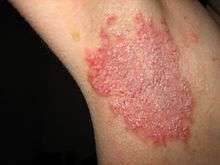Hailey–Hailey disease
| Hailey-Hailey disease | |
|---|---|
| Classification and external resources | |
| Specialty | medical genetics |
| ICD-10 | Q82.8 |
| ICD-9-CM | 757.39 |
| OMIM | 169600 |
| DiseasesDB | 29321 |
| MeSH | D016506 |
Hailey–Hailey disease, or familial benign chronic pemphigus[1]:559 or familial benign pemphigus[2]:622 was originally described by the Hailey brothers (Hugh Edward and William Howard) in 1939.[3][4] It is a genetic disorder that causes blisters to form on the skin.
Classification
While the term pemphigus typically refers to "a rare group of blistering autoimmune diseases" affecting "the skin and mucous membranes",[5] Hailey–Hailey disease is not an autoimmune disorder and there are no autoantibodies.[6] According to Pemphigus Pemphigoid Foundation (IPPF), "familial benign chronic pemphigus, or Hailey-Hailey disease, is a different condition from Pemphigus".[7]
Signs and symptoms

It is characterized by outbreaks of rashes and blisters in the skin, usually in the folds of the skins, but also often over large areas of the body. The painful blisters break and sometimes become infected and raw, with new blisters forming over raw skin in a sometimes seemingly unending cycle of outbreaks.
Causes
The cause of the disease is a haploinsufficiency of the enzyme ATP2C1;[8] the ATP2C1 gene is located on chromosome 3, which encodes the protein hSPCA1. A mutation on one copy of the gene causes only half of this necessary protein to be made and the cells of the skin do not adhere together properly due to malformation of intercellular desmosomes, causing acantholysis, blisters and rashes. There is no known cure.
The differential diagnosis includes intertrigo, candidiasis, and frictional or contact dermatitis. A biopsy and/or family history can confirm. The lack of oral lesions and intercellular antibodies distinguishes familial benign pemphigus from other forms of pemphigus.
Treatment
Topical steroid preparations often help outbreaks; use of the weakest corticosteroid that is effective is recommended to help prevent thinning of the skin. Drugs such as antibiotics, antifungals, corticosteroids, dapsone, methotrexate, thalidomide, etretinate, cyclosporine and, most recently, intramuscular alefacept may control the disease but are ineffective for severe chronic or relapsing forms of the disease. Intracutaneous injections of botulinum toxin to inhibit perspiration may be of benefit.[9] Maintaining a healthy weight, avoiding heat and friction of affected areas, and keeping the area clean and dry may help prevent flares.
Some have found relief in laser resurfacing that burns off the top layer of the epidermis, allowing healthy non-affected skin to regrow in its place.
Secondary bacterial, fungal and/or viral infections are common and may exacerbate an outbreak. Some patients have found that outbreaks are triggered by certain foods, hormone cycles and stress.
See also
References
- ↑ James, William; Berger, Timothy; Elston, Dirk (2005). Andrews' Diseases of the Skin: Clinical Dermatology. (10th ed.). Saunders. ISBN 0-7216-2921-0.
- ↑ Freedberg, et al. (2003). Fitzpatrick's Dermatology in General Medicine. (6th ed.). McGraw-Hill. ISBN 0-07-138076-0.
- ↑ synd/2081 at Who Named It?
- ↑ H. Hailey, H. Hailey. Familial benign chronic pemphigus. Report of 13 cases in four generations of a family and report of 9 additional cases in 4 generations of a family. Archives of Dermatology and Syphilology, Chicago, 1939, 39: 679-685.
- ↑ Yeh, S. W.; Ahmed, Babar; Sami, Naveed; Ahmed, A. Razzaque (September 2003). "Blistering disorders: diagnosis and treatment". Dermatologic Therapy. 16 (3): 214–223. doi:10.1046/j.1529-8019.2003.01631.x. PMID 14510878.
- ↑ Mauro, Theodora, MD. "Hailey-Hailey Disease". National Organization for Rare Disorders. Retrieved 29 October 2015.
- ↑ "Pemphigus". Pemphigus Pemphigold Foundation. Retrieved 29 October 2015.
- ↑ Hu Z, Bonifas JM, Beech J, et al. (January 2000). "Mutations in ATP2C1, encoding a calcium pump, cause Hailey-Hailey disease". Nat. Genet. 24 (1): 61–5. doi:10.1038/71701. PMID 10615129.
- ↑ Carpenter, Teresa; Merchant, Farrukh (November 2008), "Familial benign pemphigus", Consultant, 48 (12)